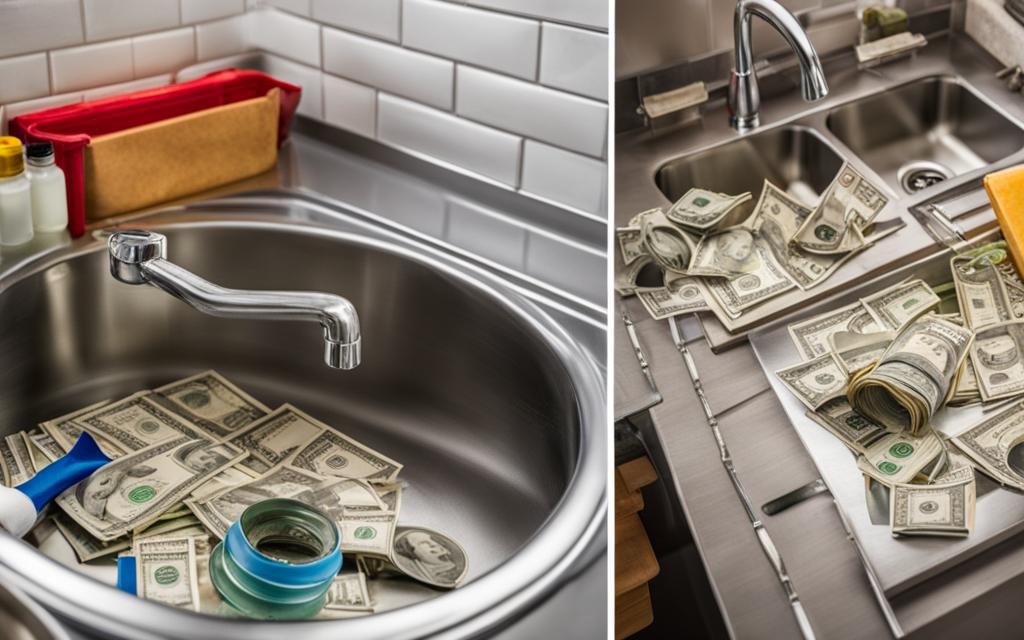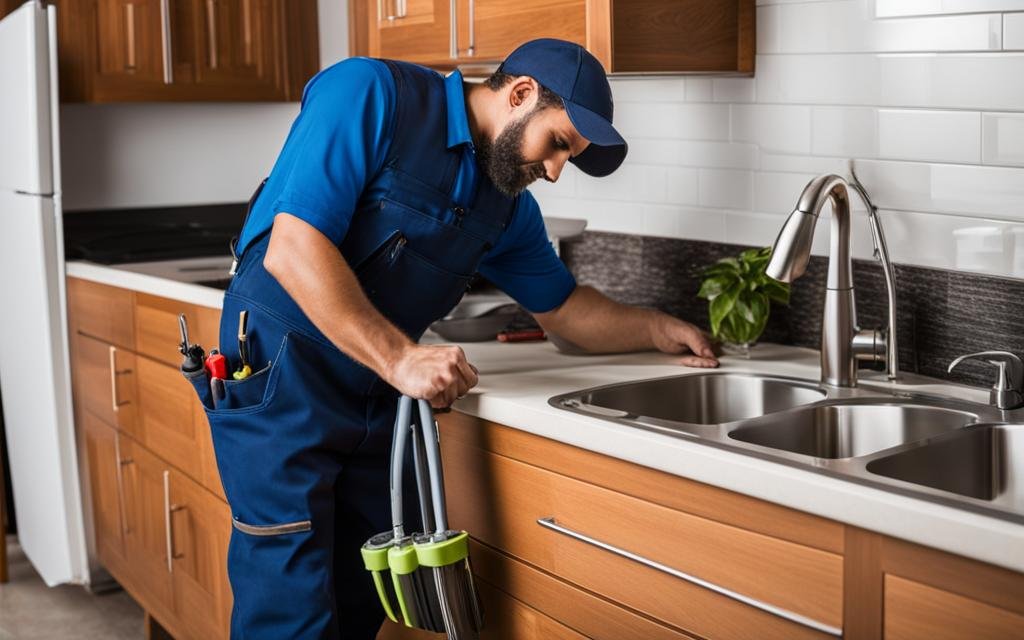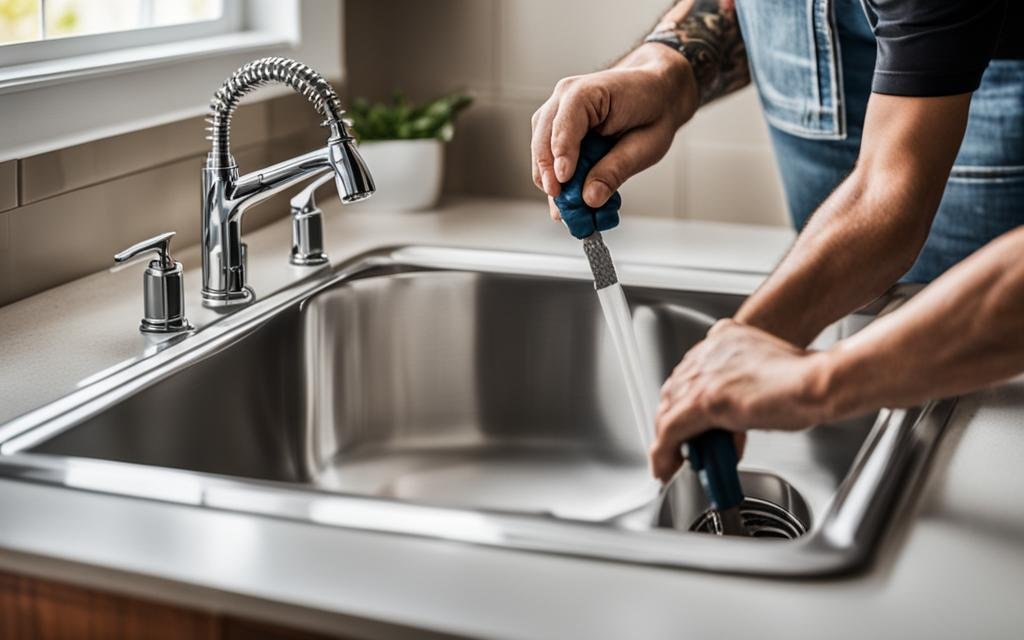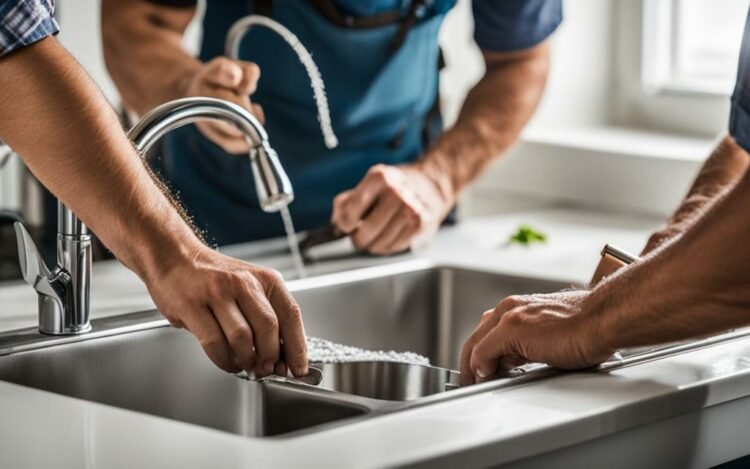Installing a new sink can be a quick way to upgrade your kitchen or bathroom. But when it comes to installation, you have two options: DIY or hiring a professional. In this article, we will compare the cost-effectiveness of DIY installation versus professional installation, and provide you with some tips for a hassle-free kitchen sink upgrade.
Key Takeaways:
- DIY sink installation can save money on labor costs, but requires skills, tools, and knowledge.
- Hiring a professional ensures proper installation, reduces the risk of errors, and provides expert advice.
- The cost of sink installation varies based on factors like sink type, material, labor charges, and geographic location.
- Consider your abilities, budget, and preferences when deciding between DIY and professional installation.
- Gather all necessary tools and supplies, read up on the installation process, and follow instructions for a successful installation.
The Cost of Sink Installation
When it comes to sink installation, understanding the cost factors involved can help you make an informed decision. The cost of sink installation can vary depending on several factors, including the type of sink, material, labor charges, and geographic location.
On average, the cost of installing a new sink ranges from $216 to $644. This price range takes into account different sink types, such as drop-in sinks, farmhouse sinks, and undermount sinks. Drop-in sinks are generally more affordable, while farmhouse and undermount sinks tend to be pricier due to their installation requirements.
It’s important to consider your budget and the specific needs of your kitchen or bathroom when determining the cost of sink installation. Additionally, labor charges can vary based on the complexity of the installation and the prevailing rates in your area.
Factors Affecting Sink Installation Cost:
- Sink type: Drop-in sinks are usually more affordable compared to farmhouse or undermount sinks.
- Material: Different sink materials have varying price ranges, with options like stainless steel, composite, and granite.
- Number of basins: Single-basin sinks are generally less expensive than double or triple-basin sinks.
- Labor: Labor charges can vary based on the complexity of the installation and the geographic location.

Understanding the cost factors involved in sink installation can help you determine whether it’s more cost-effective to opt for a DIY installation or hire a professional. In the next sections, we will explore the pros and cons of both approaches, as well as provide tips for a successful sink installation.
Pro Tip: Upgrading your Kitchen Sinks? Utilize The RTA Store military discount to enjoy savings on essential kitchen fixtures.
DIY Installation: Pros and Cons
When it comes to installing a kitchen sink, you have the option to tackle the project yourself or hire a professional. DIY installation can be an appealing choice for those looking to save money on labor costs and take pride in completing a home improvement project. However, it’s important to consider the pros and cons before diving into a DIY sink installation.
Pros of DIY Installation:
- You can save money on labor costs by doing the installation yourself.
- It can be a rewarding experience, giving you a sense of accomplishment and pride in your home.
- You have control over the timeline and can work at your own pace.
- You can customize the installation to your preferences.
Cons of DIY Installation:
- DIY installation requires additional tools and skills. If you don’t have the necessary tools or experience, you may need to invest in them or risk making costly mistakes.
- Mistakes in installation can lead to leaks, damage to pipes or cabinets, or subpar functionality.
- You may need to spend time researching and learning about the installation process, which can be time-consuming.
- In some cases, a DIY installation may void your home insurance if not done correctly.
Before deciding on DIY installation, assess your abilities, the complexity of the installation, and the level of risk you’re willing to take. If you’re confident in your skills and have the necessary tools, DIY installation can be a cost-effective and satisfying option.
Professional Installation: Benefits and Considerations
When it comes to installing a kitchen sink, hiring a professional can offer numerous benefits. Professional installation ensures that the job is done right the first time, saving you from potential headaches and costly repairs down the line. Here are some key advantages of opting for professional sink installation:
- Expertise and Experience: Professional installers have the necessary knowledge and skills to handle complex installations. They understand the intricacies of different sink types and materials, ensuring a secure and durable installation.
- Time and Convenience: Hiring a professional takes the burden off your shoulders, allowing you to focus on other tasks. Professionals can efficiently complete the installation, saving you valuable time and effort.
- Quality Workmanship: Professionals are trained to deliver high-quality workmanship. They have access to specialized tools and equipment, ensuring precision and professional results.
- Guidance and Advice: Professional installers can provide valuable guidance and advice based on their experience. They can help you choose the right sink for your needs, offer design recommendations, and address any concerns you may have.
While professional installation offers these benefits, there are also considerations to keep in mind:
- Cost: Professional installation typically comes with a higher price tag compared to DIY. It’s important to weigh the cost against the benefits to determine if it fits within your budget.
- Scheduling: Hiring a professional may require scheduling an appointment and coordinating with their availability. This factor should be taken into account if you have time constraints or a tight project timeline.
- Research and Selection: It’s crucial to research and select a reputable and trustworthy professional installer. Look for reviews, ask for recommendations, and compare quotes to ensure you hire the right person for the job.
Considering the benefits and considerations, professional installation can be a worthwhile investment for a hassle-free and successful kitchen sink upgrade.

Factors Affecting Sink Installation Cost
When it comes to installing a sink, the cost can vary depending on several factors. It’s important to consider these factors to understand the overall cost of your sink installation project.
Sink Material
The type of material you choose for your sink can greatly impact the cost. Options like stainless steel, composite, and granite have different price ranges. While stainless steel sinks are generally more affordable, granite sinks tend to be on the pricier side. Consider your budget and the desired aesthetic when selecting the material for your sink.
Number of Basins
The number of basins in your sink can also affect the installation cost. Single basin sinks are typically less expensive to install compared to sinks with multiple basins. If you require separate compartments for different tasks or simply prefer the convenience of multiple basins, be prepared for a higher installation cost.
Labor
Labor charges for sink installation can vary based on the complexity of the project and your geographic location. Hiring a professional plumber can ensure a proper and efficient installation, but it may come with a higher price tag. If you decide to go the DIY route, keep in mind that you’ll need to invest your time and effort into the installation process.
By considering these factors – sink material, number of basins, and labor charges – you can estimate the cost of your sink installation project more accurately. Remember to assess your budget and requirements before making a decision.
Tips for a Successful Sink Installation
Whether you choose to tackle the sink installation yourself or hire a professional, following these tips can help ensure a successful outcome.
Gather the Right Tools and Supplies
Before you begin the installation process, make sure you have all the necessary tools and supplies. This may include a wrench, screwdriver, plumber’s putty, silicone sealant, and any specific hardware required for your sink model. Having everything on hand will help streamline the process and prevent delays.
Read the Instructions
Whether you’re a DIY enthusiast or relying on professional help, it’s crucial to carefully read the manufacturer’s instructions. Each sink model may have unique installation requirements, and following the instructions will ensure you don’t miss any important steps. Ignoring or misunderstanding the instructions could lead to costly mistakes or improper installation.
Consider Plumbing Modifications
If you’re installing a new sink that differs significantly from the previous one, you may need to make plumbing modifications. This could involve adjusting the position of water supply lines, drain pipes, or even rerouting plumbing if necessary. Consulting a professional or a knowledgeable plumber can help you navigate any plumbing changes that may be required.
Ensure Proper Seal and Support
Whether you’re installing an undermount, drop-in, or farmhouse sink, ensuring a proper seal and support is crucial. Make sure to use plumber’s putty or silicone sealant around the edges of the sink to prevent water leaks. Additionally, provide adequate support beneath the sink to prevent sagging or damage over time.
Following these tips will help you achieve a successful sink installation, whether you choose to take on the project yourself or hire a professional. Remember to prioritize safety, read the instructions, and take your time to ensure a job well done.

Conclusion
When it comes to kitchen sink installation, you have two options: DIY or hiring a professional. Both have their pros and cons, and it’s important to consider your budget, abilities, and preferences.
DIY installation can be cost-effective, allowing you to save money on labor costs. However, it requires the right skills and tools. It’s essential to assess your own abilities and the complexity of the installation before deciding to go the DIY route. Mistakes can lead to costly repairs and may even void your home insurance.
On the other hand, professional installation ensures a proper and hassle-free installation. Professionals have the necessary skills, experience, and tools to handle complex installations. They can provide advice and guidance based on their expertise. However, professional installation comes with a higher price tag. It’s important to weigh the benefits against the additional expense and decide what suits your needs and budget.
In conclusion, whether you choose to go the DIY route or hire a professional for your kitchen sink installation, make sure to consider the factors discussed in this article. By doing so, you can make an informed decision and achieve a successful kitchen sink upgrade.

